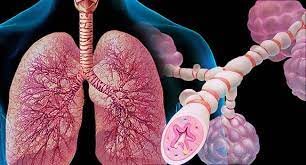Want help to write your Essay or Assignments? Click here
Chronic Asthma
Maslan & Mims (2014) define asthma as an inflammatory condition of the airway that arises due to hyperactivity to a stimuli causing obstruction of airflow, development of fatal exacerbations, and other respiratory complications. Some of the common allergens that have been citied to trigger asthma include mold spores, grass pollen, and animal dander. Medications such as aspirin, industrial materials such as toluene diisocynate, and indoor air pollution are other common triggers of asthma. Asthma can either be acute or chronic both having significant commonalities and differences.
Pathophysiology of Acute Asthma
Research has reported that exposure to inflammatory allergens triggers reactions in the respiratory system. For instance, Cardinale et al., (2013, March) reports that the onset of acute asthma involves an increased invasion of neutrophils into the respiratory system as well as tumor necrosis factor (TNF), mast cells, and eosinophils. These inflammatory mediators and cells cause increased secretion of respiratory mucous which in turn obstructs the airways, over-inflation of lungs, thickening of the basement membrane, and destruction of the epithelial membrane.
Narrowing of the airway limits inhalation and exhalation exercises of an individual. Consequently, a mismatch in the ventilation-perfusion ration arises. This means that an increase in deoxygenated blood occurs; an event that is quite fatal especially when quick medical attention is not sought.
Want help to write your Essay or Assignments? Click here
Pathophysiology of Chronic Asthma
Just like acute asthma, chronic asthma develops as a result of inflammation in the respiratory system. The allergens initiate the production of inflammatory mediators such as cytokines, histamines, and leukotrines (Maslan & Mims, 2014). These mediators trigger increased contraction and relaxation of the bronchial smooth muscles. Consequently, bouts of airway constriction develop generating the classic symptom of asthma; wheezing.
The narrowing hinders effective exhalation and inhalation. As a result, hypoxia develops and there is increased levels of carbon dioxide in the blood which affects important organs in the body especially the heart, brain, and the kidneys. A number of changes usually occur in patients suffering from chronic asthma. First, there is an increase in eosinophils in the blood supplying the respiratory system and thickening of the lamina reticularis.
The number of mucous secreting cells also increases as well as the size of the bronchial smooth muscles. If medical attention is not sought urgently, patients start presenting with lactic acidosis, hypercapnia, and an unproportional level in the acid-base level in the body. Moreover, in chronic asthma there is an increased degree of hyperactivity to stimuli and an irreversible loss of lung function due to remodeling of respiratory structures. Smooth muscle hypertrophy and hyperplasia are also common occurrences.
Risk Factor
According to Tai et al., (2014), age is one of the leading risk factor that has a significant impact on the pathophysiology of both chronic and acute asthma. Unlike adults, children are usually highly susceptible to suffering from both acute and chronic asthma. This is mainly because adults have cells that are more resistant to the inflammatory agents compared to children. Normally, adults who have previously been diagnosed with asthma can tolerate the condition for a number of weeks unlike children who can easily die within a short time after experiencing an asthma attack just as it is reported in the case of Dynasty Reese and Bradley Wilson.
It is for this reason that parents should be highly educated on the symptoms of asthma as well as the approaches they should undertake in the event a child presents with the symptoms. Moreover, parents should be enlightened about the risk factors of asthma and how they can safeguard their children from being exposed to the asthma triggers.
Diagnosis
For effective diagnosis of asthma, physicians begin by determining the chief complaint followed by the history of the presenting illness (HPI). Asthmatic patients usually complain about wheezing, coughing, tachypnea, shortness in breath just as it is reported in the case study of Dynasty Reese and Bradley Wilson. Spirometry has been tipped to be an effective approach in the diagnosis of asthma.
This technique is used in identifying the differential diagnosis by determining the FEVI of a patient. For instance, the test is positive for asthma when the FEV1 increases by about 12% while the FVC increases by about 200mL (Killeen & Skora, 2013). Chest X-rays can also be used in the diagnosis of asthma as well as the patient’s family history.
In management of asthma, patients are first given maintenance medications such as inhaled corticosteroids which include fluticasone and betamethasone. Rescue medications are then prescribed. They include bronchodilators such as salbutamol and levalbuterol. For adults with asthma, the most suitable medications are the anti-inflammatory agents such as inhaled steroids where as in children, oral medications like prednisone are recommended (Alexander et al., 2012).
References
Alexander, A. G., Barnes, P. J., Chung, K. F., Flower, R. J., Garland, L. G., Goldie, R. G., … & Lulich, K. M. (2012). Pharmacology of asthma (Vol. 98). Springer Science & Business Media.
Cardinale, F., Giordano, P., Chinellato, I., & Tesse, R. (2013, March). Respiratory epithelial imbalances in asthma pathophysiology. In Allergy and Asthma Proceedings (Vol. 34, No. 2, pp. 143-149). OceanSide Publications, Inc.
Killeen, K., & Skora, E. (2013). Pathophysiology, diagnosis, and clinical assessment of asthma in the adult. Nursing Clinics of North America, 48(1), 11-23.
Maslan, J., & Mims, J. W. (2014). What is asthma? Pathophysiology, demographics, and health care costs. Otolaryngologic Clinics of North America, 47(1), 13-22.
Tai, A., Tran, H., Roberts, M., Clarke, N., Gibson, A. M., Vidmar, S., … & Robertson, C. F. (2014). Outcomes of childhood asthma to the age of 50 years. Journal of Allergy and Clinical Immunology, 133(6), 1572-1578.
Want help to write your Essay or Assignments? Click here


